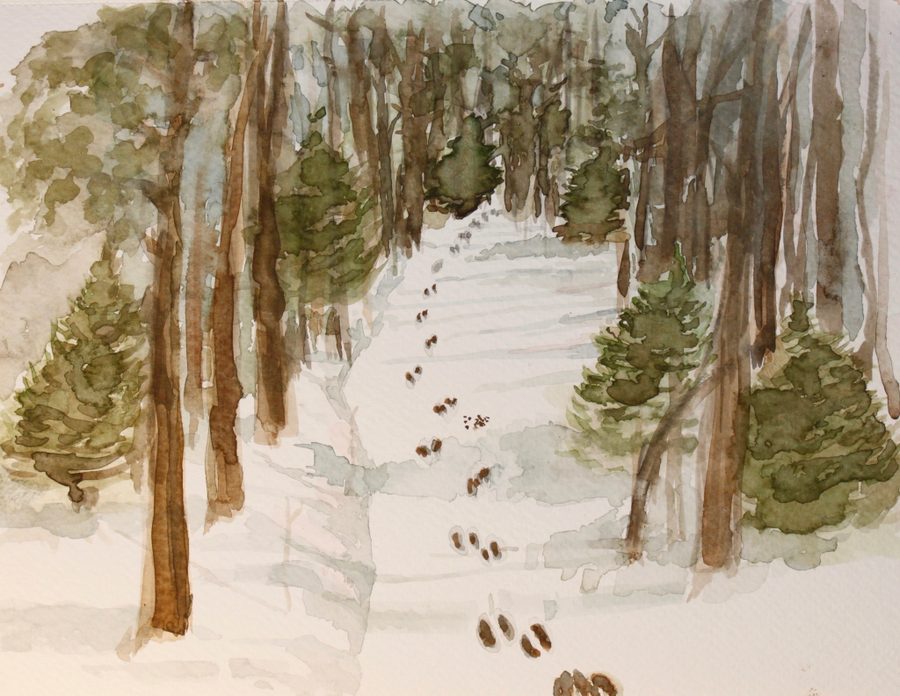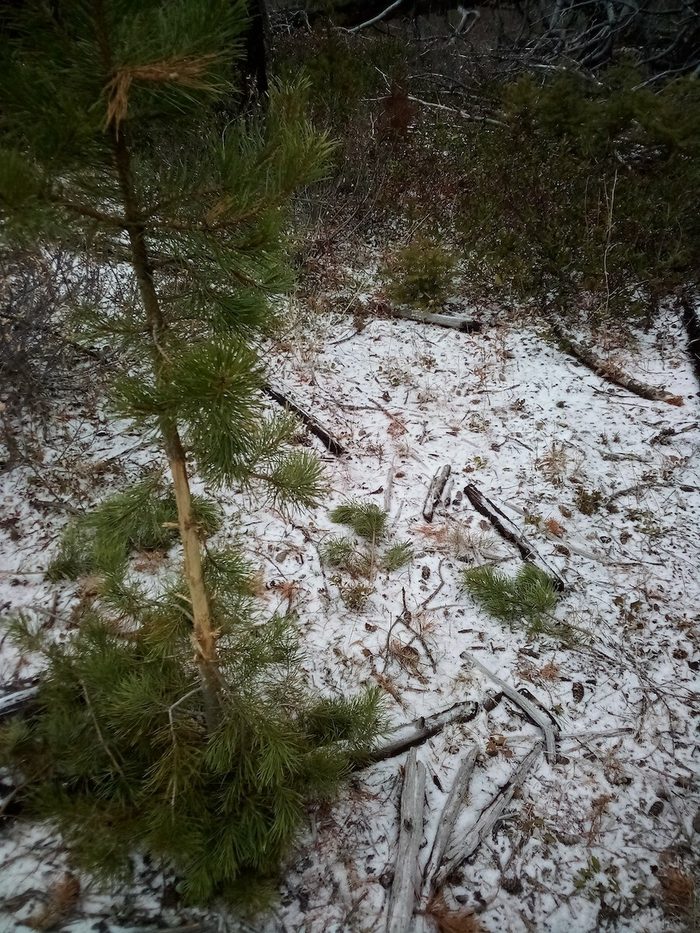In Defense of Hunting
In our age of ecological collapse, hunting animals for food is as relevant as ever.
Joseph Bullington

It’s just after dawn when I cut the tracks. Two or three of the beasts must have come up out of the valley sometime in the night and crossed the trail here before heading on into the timber to the west.
The wind, risen with the sun, whips the two-day-old snow into glittering waves that roll through the high meadows and break above the tops of the trees, drifting and dulling the edges of the tracks. In the clearings, they grow faint and I grow doubtful. These tracks are a day old, you fool. I follow them anyway, onto a burned-over slope where they vanish completely. For an hour I flounder with my rifle through the drifts and logs and scrubby young firs, breathing into my scarf to keep the frostbite off my nose, coating my glasses in a layer of ice, sure I’ve lost the trail.
But in the trees on the other side, I catch the tracks again. Here, their crescent lines show more definitely than ever. Spatters of urine stain the snow, and the air is still weighted with the last of an unruly scent. They are close. Minutes ahead of me or hours, I don’t know, but doubt has given way to the thrilling, hair-raising certainty that out there somewhere, at the end of this track, is an elk.

When in the grip of such feelings, it’s hard to understand why hunting needs defending. Besides the feelings, there’s the fact that hunting has been central to human societies, to our identity as human beings, for as long as we’ve been human. And there’s the place where the feelings meet the fact — the eerie sureness you feel, when you set off into the pre-dawn darkness with your weapons, that you are part of something ancient, that this is in you, somehow.
But hunting does need defending, these days. As the country has grown more urban, the number of hunters in the United States has declined drastically, from 17 million in 1980 to 11.5 million in 2016. Fewer people hunt and, maybe more significant, fewer people know anyone who hunts. The gulf between hunters and non-hunters has grown wide. Many people who might be interested in hunting if given the chance have been cut off from the land, tools, knowledge and culture of hunting. If you don’t have a rifle or know where to hunt, how to field dress an animal, or anyone who does, killing a deer must feel out of reach. Other non-hunters righteously oppose the practice and celebrate its decline. To their eyes, hunters often appear as vicious rednecks, children’s-book villains out to slaughter terrified animals or, worse, as plaid-jacketed aristocrats blowing stocked pheasants out of the trees on a private reserve.
Some hunters, no doubt, have earned this reputation. I have no patience for the sort who brag over a dead animal or gloat about the size of the creature’s horns — as if they grew them themselves. I have no love for the camo identity markers, the expensive and unnecessary gear, the hunting-themed beer cans or any of the other ways corporate capitalism tries to recuperate hunting into a marketable little hobby.
But a good deal of this perception of hunting is caricature, born from a lack of understanding and fed by the propaganda of a techno-culture at war with both the natural world and those who would take part of their living from outside the market. The image of the arrogant, blood-thirsty hunter is a useful scapegoat for such a culture, which depends on the daily mass death of creatures wild and tame and has no intention of changing its ways.
Beneath the caricature, though, hunting is troubled by a deeper doubt: While hunting was necessary to our ancestors, social and technological changes have made it irrelevant to our own times. Good for a thrill, maybe — “if you’re a sicko,” says the anti-hunter. “Or a sportsman,” the hunter feebly responds. And what besides fear of irrelevance would lead one to call hunting a “sport,” to place it for safe-keeping in that category of useless-but-justified fun alongside golf?
It’s true that we’ve been made comfortable, many of us at least, without hunting — but at what cost? The organized abundance in our grocery stores hides the organized misery of meat factories and chemical-drenched soybean fields. Virtual things seize an increasing share of our attention while, hidden behind our phone screens, machines tear at what little is left of the real world. Most of us grow up without any relationship to the land or the other beings who live here, without any relationship to our food or the death it depends on. To live so out of touch isn’t only dull, though that would be bad enough — in the age of climate change, when the Earth itself shifts so violently, this lack of attention to the natural world can be deadly.
To hunt is to journey out of this alienation. From planning and maps to hard hours walking the territory, learning the true meaning of topographic lines. From tracking a mountain ghost to feeling the animal’s hot blood on your hands as you care for the meat. In our times, these things are as relevant as ever.
“One of the primary purposes of hunting is to exercise our need to remain a part of the natural world,” writes Jim Posewitz in Beyond Fair Chase, a book that was required reading for the Montana hunter’s education course I took when I was 13. “Hunting is one of the last ways we have to exercise our passion to belong to the earth … to participate in the ecological drama, and to nurture the ember of wildness within ourselves.”
By itself, the visceral connection to the natural world that we can find in hunting will not defend the wild creatures and lands on which hunting and so much else depends. But without this kind of connection, we won’t find the courage to defend them.

By early afternoon, I’ve followed the elk tracks for five hours and as many miles. Soon I will have to split from them and use what’s left of my energy to get back to camp. Even so, the day has not been wasted. I grew up in the foothills of these mountains and have hunted here for years, but in a few hours the elk have shown me places and paths between them that I would not have found in another 50 years on my own. They’ve led me down into steep, sunless gulches where springs pool liquid water between iced-over banks. They’ve led me to hidden clearings in the timber where they’ve nosed still-green clumps of grass from under the snow. Rub trees, the trees where bulls strip the velvet from their antlers in preparation for the rut and combat, mark these places and the ways between them like signposts. Some of the rubs are fresh and dripping sap, some old and gray.
I didn’t grow up in a hunting family, but we lived in a small town where opening day of elk season was anticipated like Christmas and I found no shortage of teachers along the way. Brilliant, generous people who taught my dad and me where and when to look for deer and elk, how to gut an animal in the field, how to butcher the meat at home. What little more I know of hunting I’ve learned from trying to do it. Every year, my older brother and I set up our wall tent in our favorite spot and spend the week making plans, walking ourselves stupid, failing, and making new plans. Aside from some basics, learning to hunt mostly means learning a particular territory and how the animals move through it, and no one can teach you that better than the animals themselves. They’ve been here a long time, always hunted, by humans and other predators.

All of us walk in the footsteps of these human hunters who came before us. Where I grew up, the signs were everywhere if you knew where to look. My younger brother was the best at it, picking the chert and obsidian arrowheads from among the rocks and gopher mounds. On a plateau near our house we could make out, between bunchgrass and prickly pear, the pattern of stone teepee rings. Possibly an old camp of the Blackfeet, the people who were living and hunting in this area when white settlers arrived, but I don’t know. The white people who came into this valley before my family — miners and ranchers and commercial hunters, yoked to their ravenous markets and backed by their well-armed government — would’ve found it teeming with game after thousands of years of intensive hunting by Indigenous people. In a matter of decades, the colonizers exterminated the buffalo, wolves, grizzlies and most of the elk from these hills, banished the Blackfeet from these hunting grounds, and so cut the lines of knowledge that bound human beings to this land and their place in it.
Among the things that grew from the bloody ground left in the wake of this continent-wide reign of slaughter was the U.S. conservation movement. The horror, the sorrow of loss, inspired some of the newcomers to this land to defend what was left of the wild animals and their habitat. “Those people — almost without exception — were hunters,” Posewitz writes. “As early as 1871, nearly a century before Earth Day, hunters and anglers were speaking out for nature and the environment.”
This movement grew into what is known as the North American model of wildlife conservation. To this day hunters groups are often at the forefront of fights against habitat destruction and for public access to public lands. Hunters also, through license fees and taxes on ammunition, provide most of the funding for state wildlife departments, and as their numbers have dropped off so has this funding.
This model deserves plenty of criticism. It underfunds conservation of non-game species. Some hunters groups work against predator conservation for fear it will depress the number of game animals. It’s a colonial model, imposed in place of Indigenous relationships to the land and has done nothing to restore tribal sovereignty over ancestral hunting grounds. Yet without this movement the elk I’m stalking today wouldn’t be here anymore.
A tangled history put me here, following these tracks. Through it all, in spite of it and because of it, the elk have made their home here in these mountains. No doubt they’ve changed over time, adapted to the roads, the arbitrary squares of land ownership and straight lines of barbed wire. No doubt, too, they remember some of the unstraight older lines which are the real shape of the country, drawn by time not cattle companies or acts of Congress.
I only see one good way forward: Those of us descended from settlers and immigrants must entangle ourselves in relationships with this land and learn to stop owning it and start belonging to it. Today the elk have been my guides along these ancient lines and through the halls of this great home of theirs, as I try to find my way home, too.

Under the North American model, the wildlife of the United States belongs not to the monarch or the landlord but is, to use the vulgar terminology of our culture, “owned” by the public. Likewise, more than 600 million acres, or about a quarter of all U.S. land, is publicly owned — a vast American commons where anyone can walk, camp, cut firewood, fish and hunt for free, or next to it.
This is important because hunting is fundamentally an economic activity. By which I do not mean that it creates jobs or boosts the Dow-Jones Industrial. Hunting is economic in the older meaning of that word — in ancient Greek, oikonomia means “thrift” or “household management.” Specifically, hunting is a way I manage to get meat inside my household. It’s not the only way, of course. I can, and sometimes do, wash other people’s dishes or drive their fence posts or edit their articles. Come pay day, I can go to the store and trade those working hours for some ground cow or pig shrink-wrapped to a Styrofoam plate. But it’s a complicated and unpleasant way to get meat, especially for the cow or pig.
One of the joys of hunting is undercutting that bigger, nastier kind of economy by taking part of your living from outside the market. For me and many of my fellow hunters, taking meat on the commons — along with berries, mushrooms, firewood — is a counterblow in what the Austrian philosopher Ivan Illich called “the war against subsistence.” Hunting is more than an economic activity, of course, but fewer people, including me, would hunt if it was not an economical way to fill the freezer.

Some environmentalists, however, think hunting has outlived its value. John Horning, executive director of the environmental nonprofit WildEarth Guardians, put it this way in a recent blog post: “There was a time when our nation’s conservation of species and habitat was actually led by hunters…. But wildlife policy should no longer be driven by the needs of hunters. Not when more Americans, in urban and rural communities, want to coexist with wildlife — because we believe they are sentient beings with whom we share this planet.”
The implication is that hunters don’t see animals this way, that no one could possibly both respect wild animals and want to kill and eat them. Horning congratulates the increasing number of Americans who participate in “wildlife watching” instead of hunting and goes on to compare hunters to the “violent mob that attacked our nation’s Capitol” on January 6 and imply that hunting is a deviation particular to “white men.”
Horning’s argument draws from an influential tradition of Euro-American wilderness thought that sees the human species as fundamentally separate from wildlife. Our proper role in the wild is “watching.” This viewpoint implies the existence of another, un-wild world full of restaurants you can retreat to when you finish watching and where someone else, having seen to the requisite killing, will bring you your supper.
This line of thought finds more lucid expression in “An Ecomodernist Manifesto,” a 2015 document whose authors argue that, to save what’s left of nature, we humans must “decouple” ourselves from it. “Whether it’s a local indigenous community or a foreign corporation that benefits,” they write, “it is the continued dependence of humans on natural environments that is the problem for the conservation of nature.”
Where do they live, these people who call themselves “ecopragmatists,” that they can conceive of a life that does not depend on natural environments? They implore us to cut what ties we have left, to march deeper into our alienation from nature in search of some technological promised land. We will never get there but we know well enough what we will see along the way, because we see it now: people, cultures, habitats, entire ecosystems chewed up and cast off to die along the road of progress. More truly, though, most people don’t see this violence, which is another convenient function of our alienation. The killing is easier to stomach if you don’t have to look at it.
For environmentalists like these, salvation lies in retreat — retreat from direct participation in the natural world, from the animal in ourselves. Is it any wonder that this kind of environmentalism has failed to mobilize a movement capable of defeating the destroyers of our world? This environmentalism asks people to fight for something abstract, unrelated to their lives — “nature,” that thing out there. “Have you noticed,” asks the French thinker Bruno Latour in his book Down to Earth, “that the emotions involved are not the same when you’re asked to defend nature — you yawn, you’re bored — as when you’re asked to defend your territory — now you’re wide awake, suddenly mobilized?” Those of us who don’t want to live in the techno-utopian metropolis, even if it could be built, must not be tempted further into this separation from nature but must set about to overthrow it.
Not that hunting accomplishes this on its own. But it does position humans in a fundamentally different relationship to the natural world — not wreckers, not watchers, but participants finding our place among other participants.
When we hunt, we participate in a world for which life in machine civilization has not prepared us but where all the other creatures of the forest, predator and prey alike, make their home. At first we feel like strangers here and, importantly, we fail. We learn that there is no shortcut, that even the advanced technologies we carry with us cannot guarantee success. Finally, we must admit that we, too, are animals, albeit pretty sorry ones, and start to lean on our own atrophied animal senses — quiet our steps, mind the direction the wind carries our scent, sharpen not only our eyes but our ears and noses, learn the plants and to read the stories told by tracks.
Gradually, we can start to feel less like strangers. We can start to find our way back into the wild, to see it as our home, too, and defend it not as something outside of ourselves but as a whole of which we are part.

A flicker of movement stops me in my tracks. Some fifty yards up ahead, suspended between the trees — a mouth, chewing. Then into view come the eyes, ears, antlers and shaggy brown neck of a bull elk. The pines grow so thick here that I don’t see him all at once but only in parts, like a cubist painting. He turns and disappears through the trees. I can hear another elk somewhere out ahead of him, moving away. To my right, a bull stands up from his daybed and lumbers after the others. They heard me, maybe, or caught a wisp of my scent on the wind swirling through the mountains in confused gusts. I doubt they yet know what I am but they know something is on their trail, and I’ve just lost my best chance.
Through air thick with their scent, I follow them, laboring to silence each step, thinking nothing now. Their tracks lead up the left bank of a steep gulch that narrows like a V to a high point at the top of the ridge. I’m too focused on that high point and what lies beyond, and this time they see me first. Instead of cresting the ridge and dropping down, they have doubled back, contouring along the other arm of the V to check their backtrail for what creature stalks them. And there they are — three great bulls. They stand in a silent group, heads held high, and stare across the gulch at me from 75 yards away. The biggest of the three stands behind one of the others, no clean shot on either. The third bull steps clear. I squeeze the trigger.
The roar of the gun shatters the day’s quiet. I crouch there shaking with adrenaline, elk blood on the snow and my own blood singing through my ears, as this ghost I’ve tracked for hours, dreamed of for years (and I mean real, while-I’m-asleep dreams), staggers against a shattered and useless front shoulder, falls and slides to the bottom of the gulch leaving a trail of smeared blood. He lies there below me, several hundred pounds of flesh coated in coarse hair, gasping last breaths into his tattered lungs, life fading from his eyes, muscles slackening, tongue lolling out between square yellow teeth.
This, I know, is the part that horrifies the anti-hunter. I have related it in detail not because it brings me joy but because I don’t think we have the right to look away. Our life depends on the death of others. This is as true for the vegan as for the meat eater. Anyone who has taken part in this necessary killing knows it is hard, painful work. Rather than face this responsibility, though, our culture has learned to hide it from view, to shove it behind a curtain that hides the blood, muffles the screams and spits out neatly packaged pork chops and soy burgers. Behind the curtain, the killing is mostly done by immigrants and other poor people who labor gruesomely long days in fields and slaughterhouses, safely beyond the reach of our imaginations. The system is arranged in such a way that some people go their entire lives without killing a pig while others are made to kill a thousand pigs a day, every day, for years. The result of this alienation is a society of mostly clean-handed individuals who, as a whole, slaughter pathologically, easily, without feeling. Even the most gruesome kill in the woods is less barbaric.

The other bulls have vanished, deeper into their mountain stronghold. The bull dead in front of me will never run with them again, and this thought fills me with sadness. But this is not really the end of him. Soon, I will cut him open and pull out his hot guts to cool the meat and carve from behind his belly the steaming purple ropes of tenderloin. This muscle of his will, literally, become my muscle. His body will become the bodies of my friends and family, as I bore them over dinner with speeches about his cunning and bravery. It doesn’t have to get any more mystical than this to fill me with awe, with gratitude that I share in such a mysterious world.

Told truthfully, the story of a hunt would not end but start with the gunshot — because that’s when the real work begins. Tomorrow, I will return to the kill with my older brother and his wife. We will spend most of the day hauling the bull’s huge quarters back to the truck, the first half by backpack, the second by sled, and they will do more than their share of the work. (Which puts the lie to any notion of the hunter’s “personal achievement.” Elk hunting is a communal effort.) The next day, I will return for the neck meat, hide and antlers. And for weeks to come, processing the elk will consume my attention. There’s the hide to scrape, the meat to butcher, grind, wrap, smoke, dry and can. The hard, satisfying work of putting up food.
What do I owe in return? I keep this question open. My friend wrote this about killing a pig: “I looked into his eyes and saw that we were both dead. Me, food for worms. Him, food for us. It seemed equal.” Maybe it’s that simple. To pity this elk would be condescending, presumptuous — we are, both of us, but humble links in the holy meat-swap we call life. When I die, I hope to donate my body not to science but to coyotes, wolves if possible. Save an elk, eat a man.
For now, I kneel in the snow by the dead bull and take a moment to renew an old pledge — to defend his kind, his descendants and their home, as it were my home. As it is my home.
And then it’s time to get out the knives and get to work.
Joseph Bullington grew up in the Smith River watershed near White Sulphur Springs, Montana. He is the editor of Rural America In These Times.






